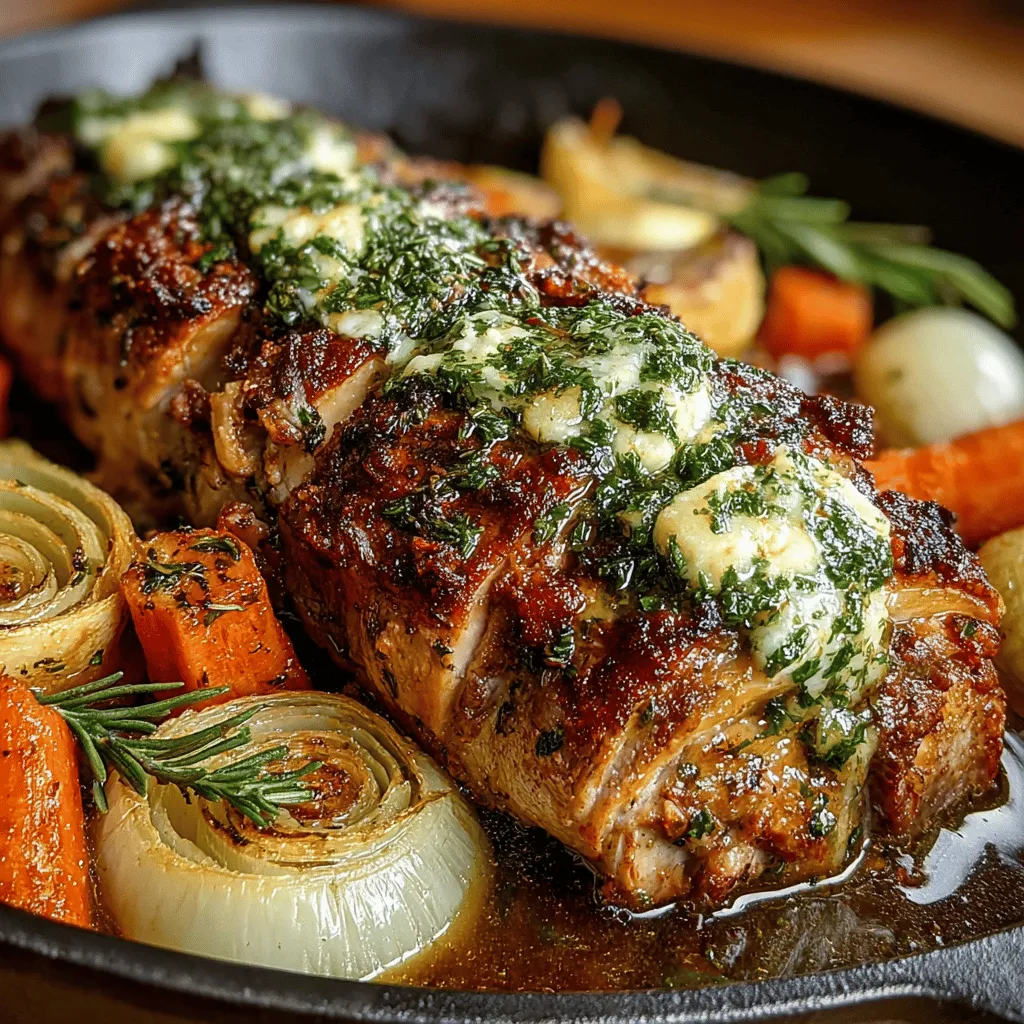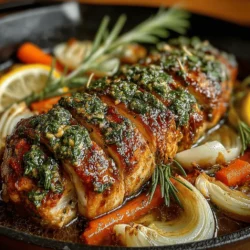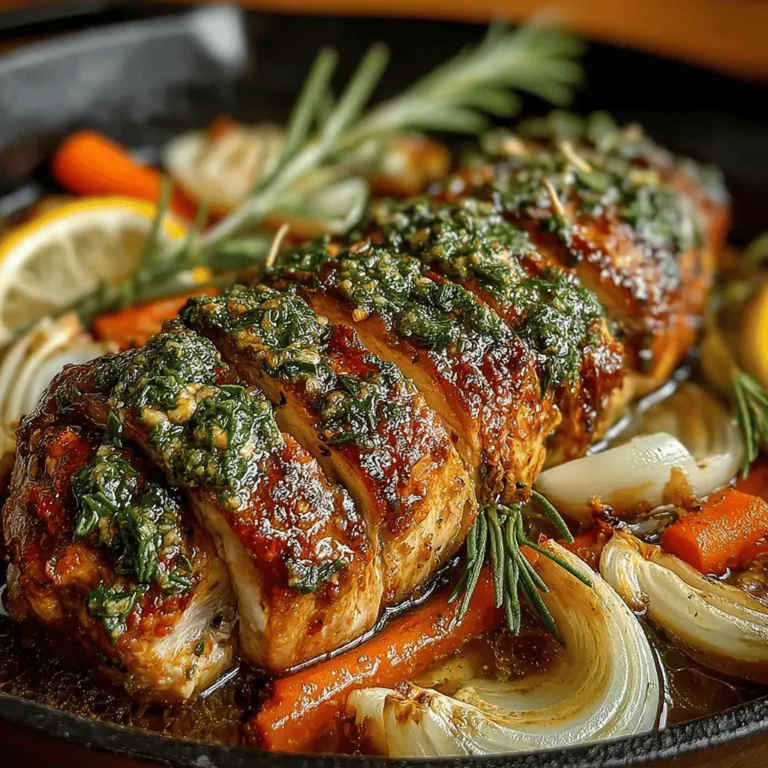Introduction
Discover the mouthwatering flavors of Herb Butter Roasted Turkey Breast, a dish that brings warmth and comfort to any table. Perfect for family gatherings, holiday feasts, or a cozy dinner, this recipe highlights the tender juiciness of turkey combined with aromatic herbs and rich butter. In this article, we will delve into the recipe, explore its unique ingredients, and provide step-by-step instructions to ensure your turkey turns out perfectly every time.
Ingredients
– 1 boneless turkey breast (about 3-4 pounds)
– 1/2 cup unsalted butter, softened
– 2 tablespoons fresh rosemary, finely chopped
– 2 tablespoons fresh thyme, finely chopped
– 2 tablespoons fresh sage, finely chopped
– 2 cloves garlic, minced
– Zest of 1 lemon
– Salt and pepper to taste
– 1 large onion, quartered
– 2 large carrots, cut into chunks
– 2 stalks of celery, cut into chunks
Instructions
1. Preheat your oven to 350°F (175°C).
2. In a small bowl, combine the softened butter, rosemary, thyme, sage, minced garlic, lemon zest, salt, and pepper. Mix well until all ingredients are thoroughly combined.
3. Pat the turkey breast dry with paper towels. This helps achieve a crispy skin.
4. Carefully loosen the skin of the turkey breast using your fingers. Be gentle to avoid tearing the skin.
5. Take half of the herb butter mixture and spread it evenly under the skin of the turkey breast, ensuring it covers the meat well.
6. Rub the remaining herb butter all over the outside of the turkey breast, making sure to coat it evenly.
7. Season the exterior of the turkey with additional salt and pepper to taste.
8. Place the quartered onion, carrot chunks, and celery in the bottom of a roasting pan. These vegetables will add flavor to the turkey as it roasts.
9. Position the turkey breast on top of the vegetables in the roasting pan.
10. Roast the turkey breast in the preheated oven for approximately 1.5 to 2 hours, or until the internal temperature reaches 165°F (74°C). Baste the turkey with its juices every 30 minutes for enhanced flavor and moisture.
Understanding the Ingredients
The Star of the Dish: Turkey Breast
Boneless turkey breast is the star of this recipe, known for its lean meat and mild flavor. Choosing turkey breast over a whole turkey provides several benefits, including shorter cooking time and easier handling, making it ideal for smaller gatherings or weekday dinners.
The Herb Butter: A Flavorful Fusion
The herb butter is what truly elevates this dish. Using fresh herbs such as rosemary, thyme, and sage adds depth and aromatic qualities to the turkey. Additionally, garlic and lemon zest play crucial roles in enhancing the overall flavor, creating a savory and tangy profile that complements the turkey.
Vegetables: The Perfect Accompaniments
Selecting the right vegetables for roasting is essential. Onion, carrots, and celery not only add flavor but also create a beautiful base for the turkey. As they roast, these vegetables caramelize, infusing the turkey with their natural sweetness and earthy tones.
Preparation Steps for Herb Butter Roasted Turkey Breast
Preheating the Oven
Preheating the oven is a critical step in achieving even cooking. An adequately heated oven ensures that the turkey breast cooks thoroughly and develops a golden-brown skin.
Creating the Herb Butter
To create the herb butter, simply mix the softened butter with fresh herbs, garlic, lemon zest, salt, and pepper in a bowl. The goal is to achieve a spreadable consistency that can be easily applied to the turkey.
Preparing the Turkey Breast
When preparing the turkey breast, start by drying it thoroughly with paper towels. This step is vital for achieving crispy skin. Next, gently loosen the skin to allow for the herb butter to penetrate the meat, resulting in a flavorful and moist dish.
Seasoning the Exterior
Don’t forget to season the outside of the turkey breast. A generous sprinkling of salt and pepper enhances the flavor of the skin, ensuring that every bite is delicious.

Tips for Ensuring an Even Coat of Herb Butter
To achieve the perfect herb butter crust, ensure that the butter is at room temperature before mixing in the herbs. This allows for easier spreading. When applying the herb butter, use your fingers to gently loosen the skin of the turkey breast. This helps the butter to penetrate deeper, enhancing the flavor throughout the meat. Be generous and apply an even layer, ensuring that all parts of the turkey are covered for maximum flavor.
Setting Up for Roasting
Arranging the Vegetables
Creating a flavorful bed for the turkey is essential for enhancing the overall taste of the dish. Use a mix of root vegetables like carrots, potatoes, and onions, which not only add flavor but also absorb the drippings from the turkey. Arrange the vegetables in a single layer in the roasting pan, ensuring that they are evenly spaced to allow for proper cooking and caramelization.
Benefits of roasting vegetables alongside the turkey include the infusion of flavor from the drippings and herbs, and the convenience of having a complete meal in one pan. The roasted vegetables will soak up the herb-infused juices, making them a delicious side that complements the turkey perfectly.
Adding Broth for Moisture
Chicken broth is essential for roasting as it keeps the turkey moist and flavorful. Pour the broth into the roasting pan before placing the turkey on top. This not only adds moisture but also creates a rich base for gravy. If you’re roasting a larger turkey, consider adjusting the liquid levels to ensure there is enough broth to sustain moisture throughout the cooking process.
Roasting the Turkey
Cooking Time and Temperature
The recommended cooking time for a turkey breast is approximately 20 minutes per pound at 350°F (175°C). However, it is critical to monitor the internal temperature to ensure the turkey is cooked properly. The ideal internal temperature for turkey breast is 165°F (74°C). Use a meat thermometer for accuracy, inserting it into the thickest part of the breast without touching the bone.
Basting for Extra Flavor
Basting the turkey intermittently during roasting enhances moisture and flavor. It is recommended to baste the turkey every 30 to 45 minutes, using the pan juices. This not only keeps the meat moist but also encourages the skin to crisp up and develop a beautiful golden brown color.
Resting the Turkey
Why Resting is Crucial
Resting the turkey after roasting is crucial for allowing the juices to redistribute throughout the meat. This step ensures that when you slice the turkey, it remains juicy and tender. Let the turkey rest for at least 15 to 20 minutes before carving. This waiting time helps in achieving the best texture and flavor.
Slicing the Turkey
When it comes to slicing the turkey breast for optimal presentation, use a sharp carving knife. Start by slicing against the grain for tender pieces. Arrange the slices neatly on a serving platter, and consider garnishing with fresh herbs or the roasted vegetables for an appealing presentation. Serving the turkey with pan juices drizzled over the top enhances the flavor and adds a beautiful sheen.
Conclusion
Herb Butter Roasted Turkey Breast is a delightful and straightforward dish that celebrates the essence of home-cooked meals. With its flavorful herb butter and perfectly roasted vegetables, this recipe is sure to impress family and friends alike. No matter the occasion, mastering this turkey recipe will bring joy to your dinner table, creating lasting memories with every bite. Enjoy the process of preparing and sharing this delicious meal, knowing that you are serving something truly special.


